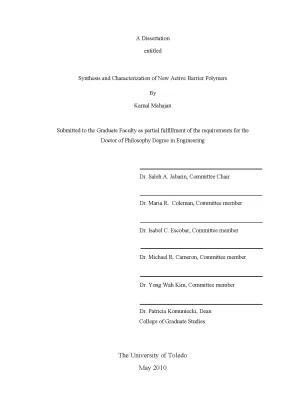Nghiên cứu tổng hợp và đặc trưng hóa các polymer rào cản hoạt tính mới
Trường đại học
The University of ToledoChuyên ngành
EngineeringNgười đăng
Ẩn danhThể loại
dissertation2010
Phí lưu trữ
40.000 VNĐMục lục chi tiết
Tóm tắt
I. Tổng quan về Nghiên cứu polymer rào cản hoạt tính mới
Nghiên cứu về polymer rào cản hoạt tính mới đang trở thành một lĩnh vực quan trọng trong ngành công nghiệp thực phẩm và bao bì. Các polymer này có khả năng ngăn chặn sự xâm nhập của oxy, từ đó bảo vệ chất lượng sản phẩm. Việc phát triển các polymer này không chỉ giúp kéo dài thời gian bảo quản mà còn cải thiện hương vị và giá trị dinh dưỡng của thực phẩm.
1.1. Định nghĩa và vai trò của polymer rào cản
Polymer rào cản là các vật liệu có khả năng ngăn chặn sự thẩm thấu của khí và hơi nước. Chúng đóng vai trò quan trọng trong việc bảo quản thực phẩm và đồ uống, giúp giảm thiểu sự hư hỏng do oxy.
1.2. Tại sao cần nghiên cứu polymer mới
Nhu cầu về các polymer rào cản hiệu quả hơn ngày càng tăng do sự phát triển của ngành công nghiệp thực phẩm. Các polymer mới có thể cải thiện khả năng ngăn chặn oxy, từ đó nâng cao chất lượng sản phẩm.
II. Thách thức trong việc phát triển polymer rào cản hoạt tính
Mặc dù có nhiều tiềm năng, việc phát triển polymer rào cản hoạt tính mới gặp phải nhiều thách thức. Các vấn đề như tính ổn định, khả năng tương thích và chi phí sản xuất là những yếu tố cần được xem xét kỹ lưỡng.
2.1. Vấn đề về tính ổn định của polymer
Tính ổn định của polymer rào cản là một yếu tố quan trọng. Các polymer cần phải duy trì hiệu suất trong suốt thời gian bảo quản sản phẩm mà không bị phân hủy.
2.2. Chi phí sản xuất và khả năng thương mại hóa
Chi phí sản xuất cao có thể cản trở việc áp dụng rộng rãi các polymer mới. Cần có các giải pháp để giảm chi phí mà vẫn đảm bảo chất lượng.
III. Phương pháp tổng hợp polymer rào cản hoạt tính hiệu quả
Các phương pháp tổng hợp polymer rào cản hoạt tính mới đang được nghiên cứu và phát triển. Một trong những phương pháp hứa hẹn là việc sử dụng các chất hấp thụ oxy hoạt tính trong quá trình tổng hợp.
3.1. Sử dụng chất hấp thụ oxy trong polymer
Việc thêm các chất hấp thụ oxy như monoolein vào polymer có thể cải thiện đáng kể khả năng ngăn chặn oxy. Nghiên cứu cho thấy rằng các polymer này có thể giảm tỷ lệ thẩm thấu oxy lên đến 40%.
3.2. Kỹ thuật polymer hóa nóng chảy
Kỹ thuật polymer hóa nóng chảy cho phép tổng hợp các polymer rào cản một cách hiệu quả. Phương pháp này giúp tạo ra các copolymer với tính chất vượt trội.
IV. Kết quả nghiên cứu và ứng dụng thực tiễn của polymer rào cản
Nghiên cứu đã chỉ ra rằng các polymer rào cản hoạt tính mới có thể cải thiện đáng kể chất lượng sản phẩm thực phẩm. Các ứng dụng thực tiễn bao gồm bao bì thực phẩm và đồ uống, nơi mà việc ngăn chặn oxy là rất quan trọng.
4.1. Ứng dụng trong bao bì thực phẩm
Các polymer mới có thể được sử dụng trong bao bì thực phẩm để kéo dài thời gian bảo quản và duy trì chất lượng sản phẩm. Điều này đặc biệt quan trọng trong ngành công nghiệp thực phẩm.
4.2. Kết quả từ nghiên cứu thực nghiệm
Kết quả từ các thí nghiệm cho thấy rằng polymer rào cản hoạt tính mới có khả năng ngăn chặn oxy hiệu quả hơn so với các polymer truyền thống.
V. Kết luận và triển vọng tương lai của polymer rào cản hoạt tính
Nghiên cứu về polymer rào cản hoạt tính mới mở ra nhiều triển vọng cho ngành công nghiệp thực phẩm. Việc phát triển các polymer này không chỉ giúp cải thiện chất lượng sản phẩm mà còn đáp ứng nhu cầu ngày càng cao của thị trường.
5.1. Tương lai của nghiên cứu polymer
Nghiên cứu trong lĩnh vực polymer rào cản sẽ tiếp tục phát triển, với nhiều công nghệ mới được áp dụng để cải thiện hiệu suất và giảm chi phí sản xuất.
5.2. Tác động đến ngành công nghiệp thực phẩm
Sự phát triển của polymer rào cản hoạt tính mới sẽ có tác động tích cực đến ngành công nghiệp thực phẩm, giúp nâng cao chất lượng và an toàn thực phẩm.
TÀI LIỆU LIÊN QUAN

Bạn đang xem trước tài liệu:
Synthesis and characterization of new active barrier polymers